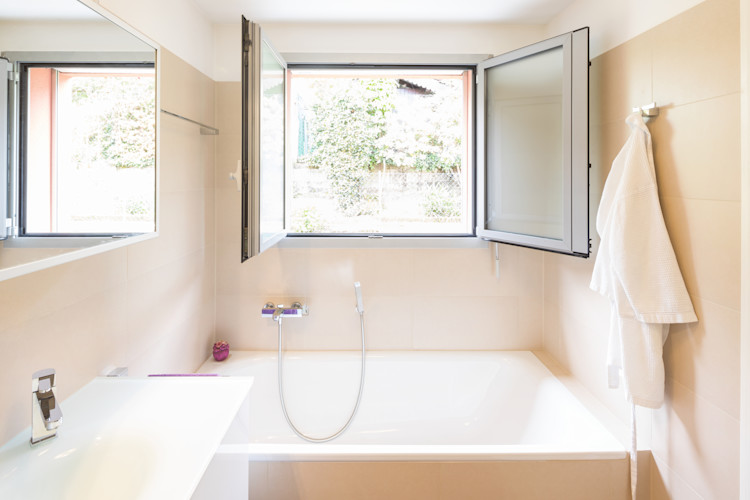Find a Cleaner near you
The average rating for Bark Cleaners is 4.78, based on 22,268 reviews
Nobody likes the sight (or smell!) of mould in their bathroom. The good news? With the right approach, you can get rid of it for good.
Natural and commercial solutions can be used to remove mould, depending on your preference, such as baking soda, vinegar, or bleach - or you can give in to mould removal sprays.
Here’s how to deal with mould in the bathroom, how to protect yourself when you’re using mould removal products, and how to prevent that mould from coming back. But we can't forget to protect ourselves when we're using these products, and we should learn how to prevent mould from coming back.
Mould thrives on damp surfaces, making your bathroom a prime target. It only needs moisture and organic material to grow, and bathrooms have plenty of both.
Damp surfaces, warm temperatures, and poor airflow create the perfect conditions for mould to spread. If moisture builds up and isn’t properly managed, you’ll usually spot it in the ceiling, especially above the shower, walls, corners, grout lines between tiles and windows.
Without regular cleaning and good ventilation, mould can spread quickly, causing damage to surfaces and a lingering smell throughout the bathroom.
Mould isn’t just a visual issue, it can affect your health and hygiene too.
Over time, according to the Australian Government Department of Health, exposure to mould spores can trigger nasal congestion, coughing, respiratory infections, worsen asthma and allergies, and irritate the skin and eyes. This is more likely to affect anyone with a weakened immune system, allergies, severe asthma or lung diseases.
Mould in indoor spaces can lead to a range of health effects, particularly when it’s not cleaned properly or left to build up. That’s why it’s so important to address it early and thoroughly.
We’ll show you the best way to clean bathroom mould along with tips to stop it from coming back!
Before you get started, make sure you’re protecting yourself.
Avoid dry brushing or scraping mould when it’s dry, as it can release spores into the air, which can easily be breathed in. Always dampen the mouldy area first and wear proper protection. It’s important to reduce exposure as much as possible, especially in enclosed spaces like bathrooms.
Wear rubber gloves to protect your skin
Use a mask (preferably a P2 or N95) to avoid breathing in spores
Open windows and doors for airflow
If you’ve got a fan, turn it on to help ventilate the space
If using spray solutions, wearing glasses is advisable

There are a few different ways to tackle mould, depending on your preferences and what you have at home.
Prefer to keep it chemical-free? These natural methods work well for mild to moderate mould patches:
White vinegar is a natural cleaner that can be used for many things around the house, including cleaning mould or mildew in smaller areas. It’s a great option if you’re trying to avoid harsh chemicals.
You can spray it directly onto the mould, or dilute it slightly with water. We recommend a 50/50 mix of white vinegar and water in a spray bottle. While vinegar is natural, it can still irritate the skin with prolonged contact.
Spray it directly on the mould and let it sit for at least an hour before scrubbing. After that, wipe clean with a damp cloth, then dry thoroughly.
Baking soda is a gentle, natural option that also works well on smaller mould patches. It cleans but also helps absorb moisture and neutralise odours, which can help stop mould from coming back, initially.
Mix ¼ teaspoon of baking soda with two cups of water to make a light solution. Apply it directly to the mouldy surface with a spray bottle or a sponge and let it sit for around 10 minutes. After that, gently scrub the area and rinse with water.
Wipe dry, then spray again with the same solution and leave it to air dry. This can help to prevent future growth.
While it can work for minor mould problems, it’s not as strong as bleach or commercial mould cleaners. If you’re dealing with a larger infestation or stubborn black mould, a tougher treatment or a professional could be the better option.
Best for: stubborn mould, silicone sealant, ceilings, and deep grout build-up
Store-bought mould removers are a stronger option for tackling built-up or recurring mould, especially in harder-to-clean spots like ceiling corners or around bathroom sealant. These products are designed to kill mould at the source and often work faster than natural alternatives.
Look for cleaners labelled "mould remover" or "mould and mildew cleaner" and follow the safety directions on the label. These are usually available at supermarkets, hardware stores or online.
Spray the product directly onto the affected surface, leave it to sit for the time recommended on the label (usually a few minutes). Scrub if required, then rinse or wipe clean and don’t forget to always ventilate the space and wear gloves or a mask if needed.
If you don’t have a specific mould remover on hand, a diluted bleach solution can also be used. You can mix one part bleach with four parts water, apply it with a cloth, scrub gently, then rinse and dry the area thoroughly.
These cleaners are ideal for more severe outbreaks but may be too harsh for some surfaces, so always patch-test first.
Once you’ve chosen your cleaner, it’s time to get scrubbing.
Here’s a simple process:
Spray or apply your chosen solution directly to the mouldy area
Wait 10–60 minutes (depending on the product instructions or method used)
Use a soft brush or cloth to scrub the surface
Rinse with clean water and dry the area thoroughly
For ceilings or hard-to-reach spots, a mop or sponge with an extendable handle can help.
Be gentle on painted or delicate surfaces to avoid damage.

Once the mould is gone, the next step is making sure it doesn’t come back. The best way to do that? Figure out what’s causing it in the first place.
Bathrooms naturally collect a lot of moisture, so it’s important to take steps that help keep the space dry and well-ventilated.
Even small changes to your routine can make a big difference when it comes to stopping mould from returning.
Ventilate your bathroom Open a window or use an exhaust fan during and after showers to let the steam escape.
Wipe down wet surfaces Dry tiles, shower screens, and benchtops after use to prevent moisture from lingering.
Fix leaks early Leaking taps, showerheads or pipes under the sink can create the perfect environment for mould.
Wash bathroom mats often Damp fabrics can trap moisture and promote mould growth if not cleaned and dried regularly.
Use anti-mould sprays or moisture absorbers These can help reduce humidity, especially in bathrooms without windows or poor airflow.
Consider anti-mould paint This is ideal for ceilings or walls that tend to attract moisture over time.
Monitor humidity levels A simple moisture meter can help. Ideally, keep indoor humidity between 30% and 60%.
Keep the space dry Wipe up any spills, and dry the walls and floors after showers or baths.
A dry bathroom is a mould-free bathroom. Staying on top of regular cleaning, drying, and airflow will go a long way toward keeping mould out of your home for good.
When removing mould, always open the windows of the room you’re working in to ventilate it. You should also keep the door to the rest of your home closed to prevent mould spores from spreading.
If you’ve done everything right and the mould still keeps coming back, or it covers a large area, it might be time to call in a professional. They can help identify any hidden moisture issues and safely treat the problem.

According to the Australian Government Department of Health, if the mould covers an area greater than one square metre, it’s recommended that the space be assessed and cleaned by a trained professional.
The mould keeps returning even after regular cleaning
The area is larger than one square metre, or it’s inside the walls or ceilings
You’re noticing health issues like allergies, breathing problems, or asthma symptoms
The mould is in hard-to-reach or porous materials like carpet or insulation
While small patches can often be handled with these cleaning methods, larger or persistent mould problems need a proper inspection and safe removal to protect your health and home.
Need help? You can find trusted mould removal specialists, deep cleaning and tile and grout cleaning professionals near you on Bark. Get a personalised quote now!
The average rating for Bark Cleaners is 4.78, based on 22,268 reviews
Want to free up some of your downtime by getting a house cleaner but not sure about costs? Find out how much you’ll pay for regular and one-off cleaning visits, deep cleans and more.